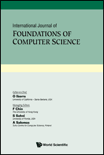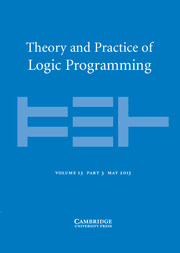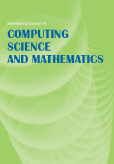
CONSTRAINTS
Scope & Guideline
Pioneering Research for the Future of Computational Sciences
Introduction
Aims and Scopes
- Constraint Satisfaction Problems (CSPs):
The journal emphasizes the study of CSPs, exploring both theoretical frameworks and practical algorithms to solve complex problems involving constraints across various domains. - Optimization Techniques:
A core focus is on optimization methods, including integer programming, linear programming, and hybrid approaches, aimed at improving efficiency and effectiveness in problem-solving. - Interdisciplinary Applications:
The journal highlights the application of constraint programming in diverse fields such as robotics, transportation, scheduling, and operations research, promoting cross-disciplinary collaboration. - Learning and Adaptation:
There is a growing interest in integrating machine learning techniques with constraint programming to enhance problem-solving capabilities, particularly in selecting encodings and improving heuristics. - Complexity and Theoretical Insights:
Research on the complexity of constraints and satisfiability provides foundational insights that inform the development of new algorithms and methodologies.
Trending and Emerging
- Machine Learning Integration:
There is a significant increase in the integration of machine learning techniques with constraint programming, indicating a trend towards adaptive algorithms that learn from data to enhance decision-making and problem-solving. - Advanced Scheduling Techniques:
Emerging research focuses on complex scheduling problems, particularly in robotics and logistics, showcasing the application of constraint programming to optimize resource allocation and task management. - Human-Centered Approaches:
A growing emphasis on human-centered design in feasibility restoration and problem-solving reflects a trend towards more practical applications of constraint programming that consider user interaction and real-world constraints. - Multivariate and Non-Binary Decision Making:
There is an increasing focus on multivariate decision trees and non-binary data classification, showcasing the journal's commitment to tackling more complex and nuanced decision-making problems. - Synchronous and Asynchronous Programming Models:
Research on synchronous programming languages for constraint search is emerging, indicating a trend towards developing new programming paradigms that enhance the expressiveness and efficiency of constraint solving.
Declining or Waning
- Quantum Annealing Applications:
Despite initial excitement, the focus on quantum annealing for solving constraint problems appears to be waning, possibly due to the challenges in practical implementation and the rapid development of classical methods. - Traditional Heuristic Methods:
The journal has seen a reduction in papers focusing solely on traditional heuristic methods for problem-solving, as researchers increasingly explore more integrated approaches that combine various techniques. - Basic Theoretical Constructs:
There is a noticeable decline in publications that primarily address basic theoretical constructs without a clear application or advanced insights, indicating a shift towards more applied and interdisciplinary research.
Similar Journals

INTERNATIONAL JOURNAL OF FOUNDATIONS OF COMPUTER SCIENCE
Transforming Ideas into Theoretical BreakthroughsThe International Journal of Foundations of Computer Science, published by World Scientific Publishing Co Pte Ltd, is a premier repository for cutting-edge research in the field of computer science, emphasizing foundational theories and methodologies. With an ISSN of 0129-0541 and an E-ISSN of 1793-6373, this journal has established itself as a valuable resource since its inception in 2000, continuously contributing to scholarly discourse up to the present year, 2024. It is ranked in the Q2 quartile of computer science categories, indicating its notable impact and relevance within the academic community, particularly in miscellaneous subsections of the field. While it does not currently offer open access options, it remains a crucial platform for researchers, professionals, and students seeking to deepen their understanding of computational foundations, algorithms, and theoretical frameworks. The journal encourages submissions that push the boundaries of knowledge and invites innovative approaches that address contemporary challenges in computer science.

Annals of Combinatorics
Exploring the Frontiers of Discrete MathematicsAnnals of Combinatorics, published by Springer Basel AG, serves as a premier platform for innovation and research in the field of discrete mathematics and combinatorics. With an ISSN of 0218-0006 and an E-ISSN of 0219-3094, the journal captures the ongoing developments and breakthroughs that characterize this dynamic discipline, which plays a crucial role in various applications such as computer science, optimization, and statistical mechanics. The journal has been recognized as part of the Q2 category in the 2023 rankings for discrete mathematics and combinatorics, reflecting its significant contribution to the academic community. Researchers and educators alike benefit from its insightful articles that not only cover theoretical advancements but also practical implications. With convergence years spanning from 2005 to 2024, the Annals of Combinatorics continues to be an essential resource for anyone looking to deepen their understanding and explore new frontiers in combinatorial research.

ORDER-A JOURNAL ON THE THEORY OF ORDERED SETS AND ITS APPLICATIONS
Exploring the Depths of Ordered Sets and Their ApplicationsORDER: A Journal on the Theory of Ordered Sets and its Applications, published by Springer, is a distinguished interdisciplinary journal that focuses on the rich and evolving field of ordered sets and their broad range of applications. With a dedication to promoting high-quality research, this journal covers key areas in Algebra and Number Theory, Computational Theory and Mathematics, Discrete Mathematics and Combinatorics, as well as Geometry and Topology, reflecting its robust impact within these domains as indicated by its current placement in the Q3 quartile across several categories for 2023. Although the journal is not open access, it serves as a vital resource for researchers, professionals, and students alike, who seek to disseminate and engage with cutting-edge findings from its inception in 1984 through to its ongoing contributions up to 2024. Its reputation is reinforced by its rankings in Scopus, rendering it an essential platform for those engaged in advanced mathematical explorations. Situated in Dordrecht, Netherlands, this journal serves as a beacon for academic collaboration and innovation in the mathematics community.

THEORY AND PRACTICE OF LOGIC PROGRAMMING
Fostering Scholarly Dialogue in the Realm of Logic Programming.THEORY AND PRACTICE OF LOGIC PROGRAMMING, published by Cambridge University Press, is a premier academic journal that delves into the evolving field of logic programming, offering insights and advancements from 2001 to 2024. With an ISSN of 1471-0684 and an E-ISSN of 1475-3081, this journal serves as a vital resource for researchers, professionals, and students interested in areas such as artificial intelligence, computational theory, and software development. In 2023, the journal was recognized for its excellence, achieving Q1 status in Computational Theory and Mathematics and Q2 in several other categories, underscoring its significant impact within the academic community. Despite not being open access, its robust content, curated by esteemed scholars, guarantees high-quality research and innovative methodologies that are crucial for advancing the field. The journal's rigorous peer-review process and its standings in Scopus rankings further emphasize its relevance and authority, making it a quintessential platform for disseminating key findings and fostering scholarly dialogue.

International Journal of Computing Science and Mathematics
Unveiling New Dimensions in Applied Mathematics and ComputationThe International Journal of Computing Science and Mathematics, published by INDERSCIENCE ENTERPRISES LTD, is a pivotal platform for the dissemination of cutting-edge research in the intertwined disciplines of computing science and mathematics. With an ISSN of 1752-5055 and an E-ISSN of 1752-5063, the journal primarily serves the academic community engaged in applied mathematics, computational mathematics, theoretical computer science, and more, making significant contributions that resonate across various fields of technology and science. While the journal is currently categorized in the Q4 quartile for multiple related fields, including Applied Mathematics and Computational Theory, it continues to strive towards advancing the knowledge and practice within these areas. Spanning years from 2007 to 2010 and again from 2012 to 2024, the journal seeks to publish high-quality, peer-reviewed articles that not only address theoretical advancements but also explore practical applications of computing science in mathematical contexts, thereby fostering collaboration among researchers, professionals, and students alike. Please note that this journal is not available as Open Access, thus ensuring a curated content selection intended for dedicated research communities.

PROGRAMMING AND COMPUTER SOFTWARE
Connecting Researchers and Practitioners in Software DevelopmentPROGRAMMING AND COMPUTER SOFTWARE is a distinguished journal committed to advancing the field of software development and programming methodologies. Published by PLEIADES PUBLISHING INC, this journal has been a valuable resource since its inception in 1978, reaching out to researchers, professionals, and students alike. With an emphasis on rigorous peer-reviewed articles, the journal holds a Q3 ranking in the realm of Software according to the latest 2023 Category Quartiles. Though it does not offer open access, the journal ensures that high-quality research is disseminated to its audience, providing insights into evolving programming techniques, software engineering challenges, and innovative solutions. With its convergence of years extending to 2024, PROGRAMMING AND COMPUTER SOFTWARE remains a pivotal publication, fostering a deeper understanding of the complexities in computer programming while supporting the broader software community.

Computer Science Journal of Moldova
Connecting Researchers to Shape the Future of TechnologyComputer Science Journal of Moldova, published by the Institute of Mathematics and Computer Science Academy, serves as a pivotal platform for disseminating research in the field of computer science since its inception in 1993. With a focus on a diverse range of subjects, including Artificial Intelligence, Computational Mathematics, and Software Engineering, this open access journal aims to foster innovation and collaboration among researchers, students, and industry professionals. Despite its current positioning in the lower quartiles as per the latest Scopus rankings, the journal remains committed to enhancing the visibility of regional research and addressing contemporary challenges through scholarly contributions. The journal’s open access model ensures that knowledge is freely available, promoting broader readership and impact within the international academic community. As it moves through the converged years from 2019 to 2024, the Computer Science Journal of Moldova continues to aspire toward empowering the next generation of computer scientists while enriching the global dialogue in this rapidly evolving field.

DISCRETE MATHEMATICS
Illuminating the path for future mathematical innovations.DISCRETE MATHEMATICS, published by Elsevier, is a leading journal dedicated to the field of discrete mathematics and combinatorics, with a distinguished presence in the academic community since its inception in 1971. With an ISSN of 0012-365X and an E-ISSN of 1872-681X, this esteemed journal has firmly established itself within the Q1 category for Discrete Mathematics and Combinatorics, and Q2 for Theoretical Computer Science as per the 2023 metrics, underscoring its pivotal role in advancing research in these vital areas. DISCRETE MATHEMATICS is highly regarded, reflected in its Scopus rankings, where it stands at #44 out of 92 in its primary category, contributing significantly to the global discourse on complex mathematical theories and applications. Published from the Netherlands, the journal serves as a crucial resource for researchers, professionals, and students looking to stay informed about the latest innovations and methodologies in discrete mathematics. Though currently not an open-access journal, DISCRETE MATHEMATICS continues to foster a vibrant scholarly community through rigorous peer-reviewed research, promoting a deeper understanding of the mathematical structures that underpin both theoretical and applied science.

Mathematical Foundations of Computing
Advancing the Boundaries of Computational MathematicsMathematical Foundations of Computing, published by the American Institute of Mathematical Sciences (AIMS), is a distinguished open-access journal that has been actively disseminating influential research in the fields of Artificial Intelligence, Computational Mathematics, Computational Theory and Mathematics, and Theoretical Computer Science since its inception in 2009. With its E-ISSN 2577-8838, this journal is committed to providing researchers and practitioners with cutting-edge mathematical theories and methodologies that underpin modern computational practices, which is critical for advancing the field. The journal proudly holds a Q3 categorization in several relevant domains as of 2023, reflecting its contribution and accessibility amid an evolving academic landscape. By offering open access to its content, it ensures that vital research is freely available to a global audience, enhancing collaboration and innovation. Positioned in the heart of the United States, Mathematical Foundations of Computing serves as a crucial resource for advancing knowledge and fostering discussions among researchers, professionals, and students passionate about the mathematical underpinnings of computing.

APPLIED MATHEMATICS AND OPTIMIZATION
Pioneering Applied Mathematics for Practical SolutionsApplied Mathematics and Optimization, published by Springer, is a prestigious journal dedicated to the rigorous exploration of applied mathematics, optimization techniques, and their multifaceted applications. Since its inception in 1974, the journal has maintained a robust reputation within the academic community, achieving a commendable Q1 ranking in both Applied Mathematics and Control and Optimization categories as of 2023. With an impact factor that underscores its influence in the field, the journal provides a platform for researchers and practitioners to disseminate innovative methodologies and significant advancements. While it does not offer Open Access, the journal’s esteemed peer-reviewed articles serve as invaluable resources for the advancement of theoretical knowledge and practical applications. Researchers, professionals, and students alike will find Applied Mathematics and Optimization an essential source for staying at the forefront of mathematical sciences, particularly in optimizing real-world systems and processes.